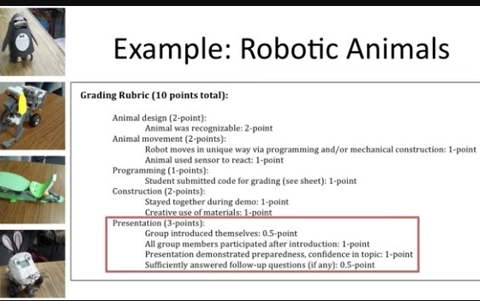Assessing students’ work in robotics

About this assessment task
In this short video, Dr Ethan Danahy talks through his assessment approach for a unit where students design and create a robotic animal in teams. This could be useful for teachers who are seeking ideas for designing assessment around robotics projects, including assessment characteristics.
Year band: 7-8, 9-10
AssessmentAssessment
The highlighted section indicates coverage of the relevant parts of the standard.
By the end of Year 8, students:
- develop and modify creative digital solutions, decompose real-world problems, and evaluate alternative solutions against user stories and design criteria. Students acquire, interpret and model data with spreadsheets and represent data with integers and binary. They design and trace algorithms and implement them in a general-purpose programming language. Students select appropriate hardware for particular tasks, explain how data is transmitted and secured in networks, and identify cyber security threats. They select and use a range of digital tools efficiently and responsibly to create, locate and share content; and to plan, collaborate on and manage projects. Students manage their digital footprint.
By the end of Year 10, students:
- develop and modify innovative digital solutions, decompose real-world problems, and critically evaluate alternative solutions against stakeholder elicited user stories. Students acquire, interpret and model complex data with databases and represent documents as content, structure and presentation. They design and validate algorithms and implement them, including in an object-oriented programming language. Students explain how digital systems manage, control and secure access to data; and model cyber security threats and explore a vulnerability. They use advanced features of digital tools to create interactive content, and to plan, collaborate on, and manage agile projects. Students apply privacy principles to manage digital footprints.
Assessment
Description
In this 7-minute video, Dr Danahy from Tufts University Engineering and Outreach Centre talks through his assessment framework for his students’ team robotics projects. The students are in a first-year undergraduate engineering course, and use LEGO NXT. Although Dr Danahy talks about assessment for college students, ideas from his approach and key indicators for assessment can transfer to bands 7–8 and 9–10.
Dr Danahy shares his assessment components, which include: weekly challenges, a final project (design documents, development, self- and peer-grading and presentation) and a midterm exam. In the video, Danahy explains the assessment criteria in the context of designing a robotic animal. Advice from his assessment framework can be adapted for other robotics projects.
Dr Danahy talks through the characteristics of assessment, which include looking at: design, interactions/interface, programming/code (functionality, structure), construction/stability, performance, presentation and documentation. Situated in the context of a robotics animal project he describes how he breaks down the marking criteria around these characteristics.
This video could provide a starting point for educators before moving on to more rigorous assessment design and planning.
Guidance For Use
This video could be used for personal professional learning, or viewed by a group of teachers in a school before designing assessment for a robotics project.
Advice
- At the start of the unit Danahy provides a syllabus to students that explains the course content, assessment and learning intentions. It also describes engineering content and other relevant skills that will be explored in the unit.
- He has students submit their work to an online environment to display their design documents, code, videos, images of their robot, etc. These can be reviewed by educators for formative and summative assessment. He uses this to provide feedback to the groups.
- His exam questions include questions testing students’ abilities to read/analyse and debug code, and their conceptual understandings, among other elements.
- Consider co-designing assessment rubrics with students at the start of the unit.